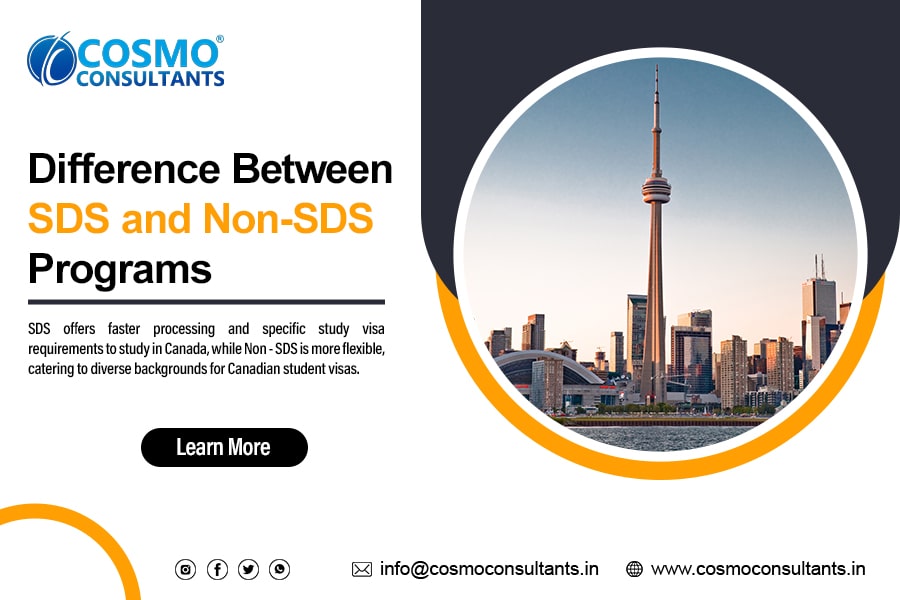
Hey there, Applicant! Are you dreaming of pursuing your education in the Great White North? But
hold on, before
you pack your bags and hop on a plane, there's one thing you gotta know – the SDS and
Non-SDS program
classification. Understanding these two study-abroad pathways is like having a secret map to
unlock the doors to
your Canadian academic journey.
Trust me; you don't want to get lost in the application process! Let's go underwater and
explore the amazing
opportunities in the land of maple syrup and friendly faces with these programs!
The SDS program streamlines study permit applications for international students from specific countries, offering a fast pathway to study at designated learning institutions (DLIs) in Canada. It's open to students pursuing post- secondary education at the diploma, degree, or post-graduate level.
To be eligible for the SDS program, prospective students must meet certain criteria set by the Canadian government. These requirements include:
Students must have a valid letter of acceptance from a Designated Learning Institution in Canada to apply under the SDS program.
Applicants must pay the first year's tuition fees upfront for the academic program they intend to pursue in Canada.
Students need to purchase a GIC from a participating Canadian financial institution to demonstrate sufficient funds to cover living expenses for the first year of study in Canada.
Students from some countries may be required to undergo a medical examination before applying for a study permit.
Students must demonstrate their language proficiency in either English or French by providing test scores from approved language tests like IELTS, TOFEL or TEF.
Opting for the SDS program offers several benefits and advantages for international students:
One of the most significant advantages of the SDS program is the faster visa processing time, allowing students to receive their study permit more quickly than through regular study permit applications.
The SDS program has a clear and transparent application process, making it easier for students to understand the requirements and ensure they have all the necessary documents in place.
By fulfilling the upfront payment of tuition fees and demonstrating sufficient funds through a GIC, students can have peace of mind knowing their financials are for the first year of study.
After completing their studies in Canada, graduates under the SDS program may be eligible for a post-graduation work permit, allowing them to gain valuable work experience in the country.
Students who choose SDS can access some of the finest Canadian educational institutions and pursue their academic goals with confidence.
The SDS program serves as a fantastic opportunity for international students seeking to study in Canada.
Non-SDS programs refer to study permit applications for international students who do not fall under the Study Direct Stream (SDS) program in Canada. Unlike the streamlined and expedited process of the SDS program, Non- SDS applications are processed through the regular study permit route. SDS focuses on post-secondary education, while Non-SDS covers language courses, secondary education, and short-term studies.

Admission requirements and application process for Non-SDS programs vary based on the educational
institution,
program level, and course of study. Unlike SDS, Non-SDS offers more flexible financial
requirements and language
proficiency options.
Academic prerequisites like previous qualifications and test scores
may differ, so researching and meeting specific
criteria is essential.
Non-SDS programs encompass various study categories, each carrying its implications for international students:
Students who wish to improve their language skills before pursuing a degree in Canada can enroll in language courses. These courses are essential for those who do not meet the language proficiency requirements of their desired academic program.
Non-SDS includes applications for secondary education, allowing international students to complete their high school studies in Canada and prepare for higher education in the country.
Students interested in short-term study programs, such as summer courses or exchange programs, fall under the Non-SDS category. These programs offer international exposure and cultural immersion without the need for a long-term study permit.
For some post-secondary programs, especially those with a duration of less than eight months, students may not be eligible for a Post-Graduation Work Permit (PGWP) after completing their studies.
Understanding non-SDS programs is vital for international students in Canada. Recognize variations in requirements, processes, and program categories to confidently pursue academic goals.
Studying in Canada as an international student offers various pathways, including the Study Direct Stream (SDS) and Non-SDS programs. Understanding the key differences between these two options is crucial for prospective students. Let's explore differences in processing times, visa procedures, language requirements, and financial documentation for SDS and non-SDS programs.
One of the significant advantages of the SDS program is its faster processing time. SDS applications generally receive quicker turnaround times compared to non-SDS applications.
Non-SDS applications, on the other hand, follow the regular study permit route and may take longer to process. Processing times vary based on factors like the student's country and application volume.
The SDS program requires students to demonstrate proficiency in either English or French through approved language tests, such as IELTS or TOEFL.
Non-SDS programs may have varying language proficiency requirements depending on the educational institution and the specific program of study.
SDS applicants are required to pay their first-year tuition fees upfront and purchase a Guaranteed Investment Certificate (GIC) to demonstrate sufficient funds for their living expenses in Canada. The specific amount for the GIC varies depending on the institution and location of the study.
Non-SDS programs may have different financial documentation requirements. Students still need to show enough funds for tuition and living, but specifics can differ among programs.
SDS and Non-SDS offer distinct pathways for studying in Canada. SDS is faster with specific requirements, while Non-SDS offers flexibility but may take longer.
Studying in Canada as an international student involves essential visa and immigration considerations.
Students applying under the SDS program must submit their study permit application electronically and ensure that all required documents are in order before applying.
The SDS program requires specific documentation, including a valid letter of acceptance from a Designated Learning Institution (DLI), proof of upfront tuition payment, purchase of a Guaranteed Investment Certificate (GIC) for living expenses, language proficiency test results, and a medical examination (if required).
Non-SDS students follow the regular study permit process, submitting applications through appropriate channels and meeting requirements.
Non-SDS applicants have more flexibility in documentation requirements than SDS. They still need a valid acceptance letter and sufficient funds, but specifics may vary by institution and program.
Both SDS and non-SDS students require a study permit to study in Canada. The study permit is an official document that allows international students to pursue their academic programs in the country.
Under the SDS program, students may be eligible for a Post-Graduation Work Permit (PGWP) upon completing their studies. The PGWP allows graduates to gain valuable work experience in Canada, which may lead to opportunities for permanent residence. Non-SDS students can also be eligible for a PGWP, depending on the duration of their study program.
Both SDS and Non-SDS students have various post-graduation options in Canada. They can choose to apply for a PGWP to gain work experience, explore pathways to permanent residency through provincial nomination programs or federal immigration streams, or pursue further studies in Canada.
The majority of colleges in Canada possess a Designated Learning Number (DLN) that includes the institution as part of the SDS program collaboration. Below, we have listed a few SDS colleges in Canada for your reference:
Please note that this list is subject to change, and it is always best to verify the latest information with the respective institutions or the official Canadian government website.
To sum up, knowing the differences between SDS and non-SDS is required for international
students in Canada. SDS
offers faster processing and specific requirements, while Non-SDS is more flexible, catering to
diverse backgrounds.
Choose the best fit for your dream education!
Students must select between SDS and non-SDS based on their circumstances and goals. Consider
academics,
language proficiency, finances, and career plans. Both programs offer transformative experiences
in Canada.
Whether you prefer speed with SDS or a personalized approach with Non-SDS, Cosmo Consultants
will guide you
toward your dream education in Canada. Let's make your study abroad dreams a reality!
